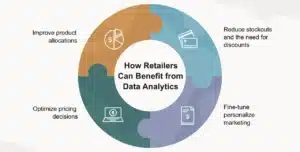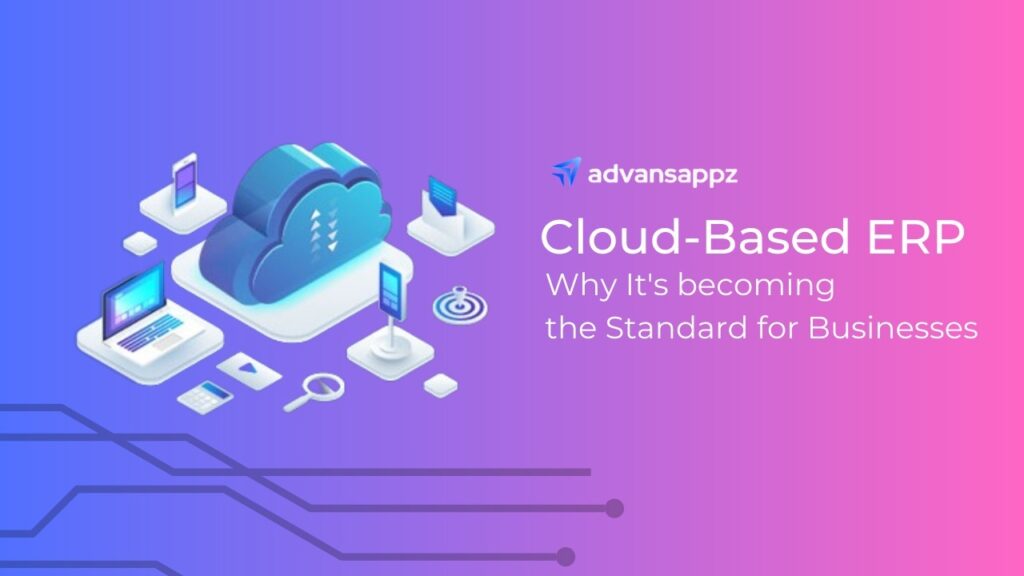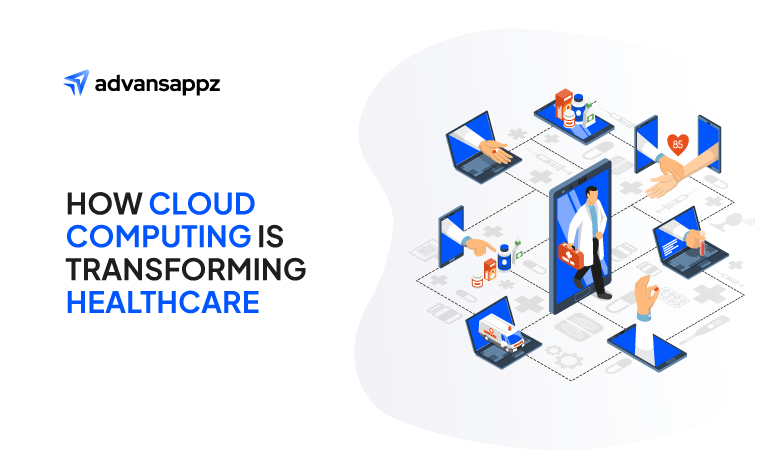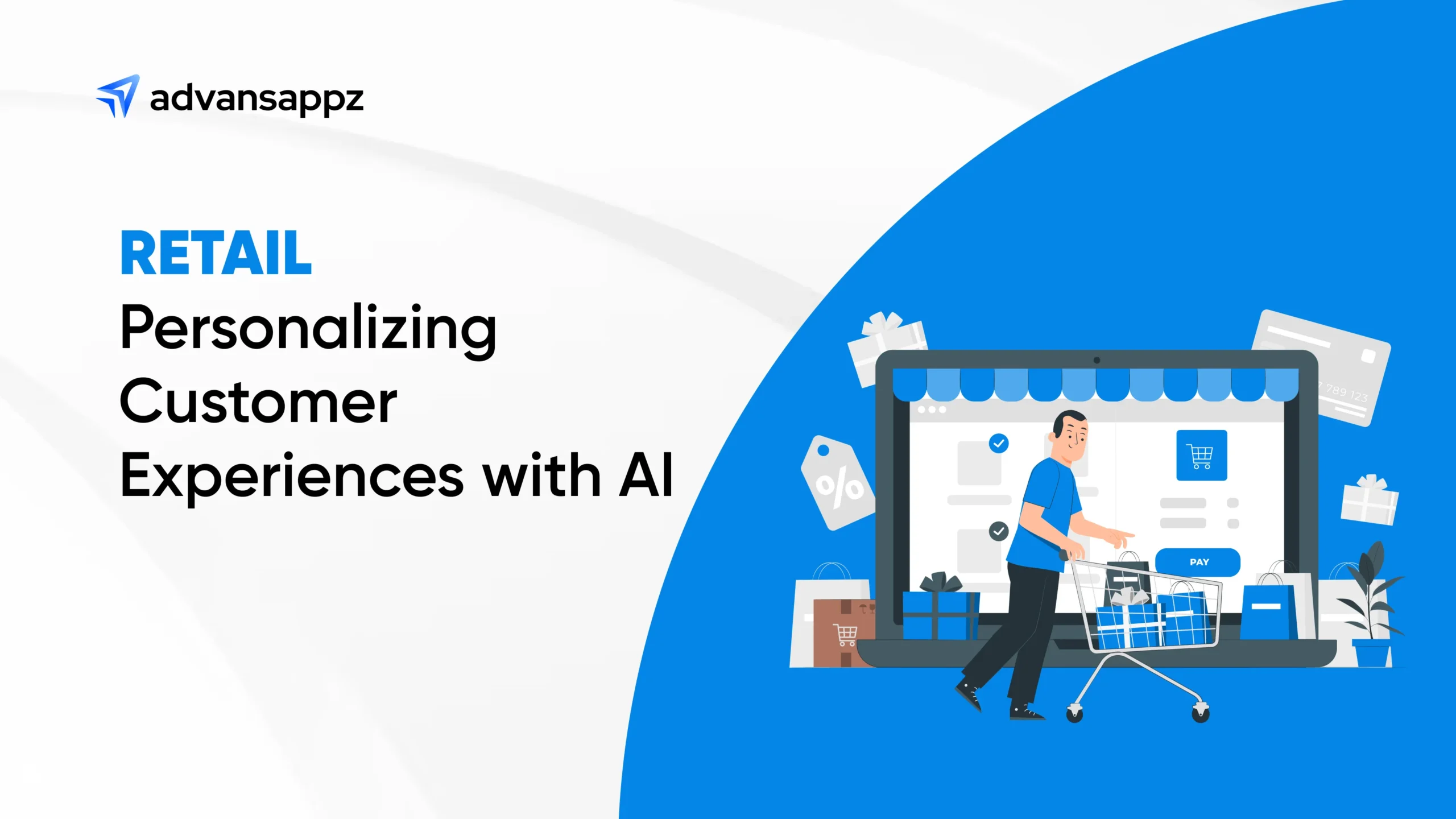The retail industry has faced significant challenges recently, affecting every aspect of its operations. Due to changing client preferences, retail has transformed its product offers to match market realities.
As technology advances, industries constantly adapt to keep up with the times. One industry that has seen a significant transformation in recent years is the retail industry. An informative Accenture survey found that 91% of consumers prefer brands that recognize, recall, and provide relevant offers and recommendations.
With the help of data analytics, retailers can gather valuable insights about their customers and purchasing behavior, allowing them to make more informed decisions about their products and marketing strategies. In this blog, we’ll explore how data analytics revolutionizes the retail industry and what it means for retailers and consumers.
What Is Retail Data Analytics?
The dynamic process of Data analytics in retail uses big data to optimize supply chain processes, strengthen consumer loyalty, and adjust pricing tactics. In this context, big data is a vast body of information that may be used to identify complex patterns, trends, and relationships, particularly concerning human behavior and interaction.
Three crucial characteristics—volume, velocity, and variety—have historically defined big data. This richness of knowledge in retail translates into a thorough awareness of consumer buying behaviors and the knack for luring new customers.
By utilizing big data analytics, retail businesses can build consumer suggestions based on a person’s purchasing history, resulting in individualized shopping experiences and notably improved customer care. The ability to foresee new trends and create strategic decisions based on in-depth market study is another significant application of these vast datasets.
Roles of Data Analytics in Retail Industries
Influencing every aspect of our everyday lives, data analytics has emerged as a crucial force in the future of the retail industry. Let’s examine the vital functions that data analytics plays in the world of retail:
Increased Product Sell-Through Rates
Data analytics in the retail sector looks deeply into particular data to align with customer demand and pleasure. This calls for the careful examination and enhancement of unique pricing schemes. In the retail industry, attracting and keeping customers is crucial, and data analytics helps customize focused campaigns to achieve maximum success by offering specialized goods and services.
Pricing Optimization
Data analytics have revolutionized price optimization in the retail industry. Products are meticulously inspected, and pricing tactics are perfected using cutting-edge data analytics.
Anticipating Supply Chain Disruptions
Retail sectors use data analytics to access external data sources and evaluate their influence on the commercial environment to anticipate supply chain disruptions. Real-time data is used to foresee and minimize supply chain disruptions and ensure profitability.
Demand and Supply Forecasting
Accurate demand and supply forecasting is essential for adjusting supply to changing corporate market demands. Retail industries can now forecast future inventory levels, anticipate revenue trends, and forecast production growth thanks to data analytics. This priceless knowledge promotes overall corporate operations and helps with strategic decisions.
Refining Marketing Mix
Data analytics is crucial to fine-tuning the marketing mix to increase productivity shortly. Given the rapid acceleration of change and technology improvements, the retail industry must reassess many marketing strategies to succeed. Data analytics supports analyzing and optimizing the marketing mix for better results by altering analytical models.
What Benefits Does Data Analytics Have for the Retail Sector?
- Increasing Sales through Optimal Pricing: Data analytics now plays a vital part in determining product prices in the market due to technological advancements. The optimal pricing strategies aim to ascertain how price changes boost demand and entice consumers to investigate product bundles. Retail sectors can use data analytics to improve customer service overall and streamline the customer journey.
- Uncovering Customer Insights from their Journeys: Data analytics is a powerful tool for drawing insightful conclusions from customer activity and discovering Customer Insights from their Journeys. Data analytics examines the customer journey, which is frequently complicated and involves several digital channels, to identify patterns of market interaction and determine which customers are most important.
- Elevating Personalization: The consumer takes center stage in retail, and data analytics is the key to unlocking tailored experiences. Data analytics aids retailers in personalizing offerings to customers’ interests by analyzing data from marketing efforts, product recommendations, and previous purchases.
- Market Trend Prediction: Data analytics uses sophisticated algorithms to predict market trends and product demand before products hit the shelves. For example, seasonal sales increase around holidays because data analytics forecasts increase market activity, frequently assisted by sentiment analysis to assess general market attitude. Retailers can stock products likely to become popular at particular times because of these predictive capabilities.
- Utilizing Virtual Applications: Retail data analytics puts the consumer experience first and uses customer feedback to evaluate products and brands. Virtual apps are essential in this procedure since they save expenses and make product exchanges easier. Additionally, data analytics helps measure product sizes and provide insightful information based on prior purchases, improving the consumer experience.
Use Cases Of Data Analytics In The Retail Sector
Customer Segmentation
By segmenting their consumer base based on demographics, preferences, and past purchasing behavior, data analytics has enabled retailers to obtain profound insights into their customer base. Retailers may create specialized marketing tactics and offer individualized experiences thanks to this segmentation, which promotes customer pleasure and loyalty. Notably, a McKinsey study indicated that businesses that use customer analytics generate a staggering 126% more profit than their rivals.
Forecasting demand
Accurate demand forecasting is essential in the retail industry for efficient inventory management, minimizing stockouts, and reducing overstocking. Data analytics is crucial in forecasting future demand trends by examining previous sales data, outside variables like seasonality or promotions, and even sentiment analysis from social media.
A recent Accenture investigation found that implementing a consolidated picture of demand across different sites increased forecast accuracy by about 6–8 percent, possibly generating $100–130 million in benefits.
Optimizing the price
Retailers use data analytics to analyze market trends, rival retailers’ price plans, and consumer behavior to optimize pricing strategies. By calculating price elasticity, merchants may identify the perfect pricing points for their goods and balance client demand and profitability. When businesses use data analytics to fine-tune pricing, performance often improves by 2-4% and annual sales rise by 1-2%.
Recommender Systems
Retailers can use data analytics to develop recommender systems that provide customers with tailored product recommendations. By examining consumer preferences and purchase history, these systems improve cross-selling and upselling prospects, boosting customer engagement and generating revenue. As an illustrative case, Amazon attributes 35% of its sales to its personalized recommendation engine.
Identifying fraud
Data analytics is crucial for businesses to detect and stop fraudulent actions like payment and return fraud. Retailers can identify abnormalities and take preventative action to safeguard their business and customers by studying transaction data and behavior trends.
According to the National Retail Federation, there are yearly damages from fraud of almost $100 billion, underscoring the critical role of Data analytics in the retail industry.
Hyper-personalization retailers may develop highly focused marketing campaigns, provide individualized advice, and develop specialized specials through in-depth analysis of vast customer data, including purchase history, browsing behavior, and demographic data. According to Evergage’s survey, 88% of marketers observed results from personalization initiatives, leading to higher visitor engagement and conversion rates.
Improved supply chain effectiveness
Retailers increasingly use advanced analytics to estimate demand correctly, reduce stockouts, optimize inventory levels, and simplify logistics. Data-driven supply chain analytics also lower forecasting mistakes, cut storage expenses, and reduce administrative costs for businesses.
Virtual reality (VR) and augmented reality (AR) integration
Data analytics to improve customer experience is about to transform because of the combination of data analytics and AR/VR technologies. Thanks to these immersive technologies, retailers will be able to provide interactive product demos, virtual store tours, and virtual try-on experiences. By 2025, the Snap Consumer Global AR research predicts that nearly all smartphone users, or around 75% of the world’s population, will be frequent AR users.
Common Challenges of Retail Data Analytics
In the ever-changing retail sector, Big Data is essential for optimizing operations and driving business processes. Retail data analytics is complicated, especially with large and complex information. This article discusses these issues and their effects on retail.
- Data Quality and Integration: Data from several sources can contain redundancy, inconsistencies, and inaccuracies. Retailers must adapt and standardize this diverse data for helpful analysis. Data from many seeds must be accurate to yield relevant insights.
- Data Privacy and Security: Conforming to a maze of data privacy rules and regulations is a significant barrier for merchants. Compliance is becoming harder as these regulations get more complicated. The GDPR has strict data residency and processing location requirements. Retailers must use Role-Based Access Control (RBAC) to protect sensitive consumer data such as banking information, social security numbers, and birthdates.
- Technology Infrastructure: Handling large datasets requires a solid technology infrastructure for scalability and computing. This pursuit has various challenges. Choosing the best technology among many possibilities takes time and effort.
- E-commerce is a vital aspect of retail. This sector has challenges:
An in-house data pipeline for ingesting data from various sources takes time, effort, money, and engineering personnel.
Analysis often needs to be more accurate due to difficulties integrating e-commerce data with marketing automation systems.
To maximize retail data analytics and stay ahead in a competitive industry, merchants must master three issues.
Solutions to Retail Data Analytics Challenges
- Data Integrity and Quality: Implement reliable data validation procedures to guarantee accuracy. Use data purification tools to find and fix mistakes. To facilitate integration, standardize data formats. Invest in a data integration platform to simplify the process and reduce duplication.
- Data Security and Privacy: To comply with data regulations, keep your data protection policies current. To protect sensitive consumer information, make investments in encryption technologies. Conduct data privacy training for your staff. Take into account utilizing safe cloud providers that adhere to regulations.
- Technology Infrastructure: Prioritize technology purchases according to particular business requirements. To select appropriate tools and platforms, seek the advice of specialists. Use cloud computing to scale efficiently and at a low cost. To save time and money, think about outsourcing data pipeline management.
Automating data integration procedures with appropriate software and utilizing API connections for marketing tools will help with e-commerce issues and ensure proper analysis.
Future Trends of Data Analytics in Retail Industry
Future developments in the retail sector’s adoption of data-intensive digital technology will propel the field of retail analytics to play an ever more important role. Notably, adopting AI, IoT, and 5G will completely alter the retail industry.
Artificial intelligence (AI)
Effective data analytics tools are required to integrate AI and machine learning into retail operations smoothly. The foundation of AI and machine learning, data analytics provides the knowledge required to automate decision-making through independent testing and learning cycles carried out automatically by computers.
Internet of Things (IoT)
IoT (Internet of Things) system proliferation in the retail industry requires strong analytics capabilities for maximum efficiency. IoT devices interact with one another across the network and exchange information about their operational state. This interconnection is extremely useful for inventory management, logistics, supply chains, and in-store operations in the retail industry.
Analytics platforms examine the data flow and create practical plans for these devices.
5G Connectivity
Enhanced data analytics capabilities are required to handle the massive amount of data that 5G connectivity will enable. Faster data transmission speeds brought on by 5G enable huge information processing inside brick-and-mortar establishments. This opens the door for a wider uptake of data-rich technologies like augmented reality, computer vision, and picture recognition.
In turn, these technologies make it possible to identify, react, and communicate with customers in real time based on their behavior in-store. As a result, this promises higher customer involvement in actual retail locations and a more tailored purchasing experience for customers.
Also Check: Everything You Need to Know About a Data Warehouse
The End Note
The retail business has transformed to improve productivity and meet customer needs in an age of technological innovation and digitalization. Strategic data analytics has helped the retail sector adapt and grow by effortlessly integrating consumer loyalty into purchasing.
Undoubtedly, data analytics has changed retail. It has increased e-commerce, customer satisfaction, and retail income. As we use data more, retail will offer greater chances to personalize experiences and optimize the sector.
advansappz is a reliable and experienced partner in this dynamic retail evolution, helping its customers manage data analytics. Team advansappz helps you use your data to expand your business and confidently embrace the future of retail as a trustworthy data analytics firm.
Let us help you achieve data-driven success and customer-centric excellence in retail data analytics.
Frequently Asked Questions
Data analytics in retail refers to the process of collecting, analyzing, and interpreting data related to various aspects of retail operations, such as customer behavior, sales trends, inventory management, and supply chain optimization. It involves using data to make informed decisions that can improve business performance and customer satisfaction.
Data analytics helps retailers gain valuable insights into customer preferences, optimize pricing and promotions, manage inventory efficiently, and enhance the overall shopping experience. It enables data-driven decision-making, which can lead to increased revenue and profitability.
Retail data analytics typically involves the analysis of various types of data, including sales data, customer data (demographics, purchase history), inventory data, supply chain data, and even external data like weather or economic indicators, depending on the specific goals of the analysis.
Data analytics can help retailers predict demand more accurately, reduce stockouts and overstock situations, optimize reorder points, and streamline supply chain operations. This leads to lower carrying costs and improved customer satisfaction.
Customer analytics helps retailers understand customer behavior, preferences, and buying patterns. It enables the creation of personalized marketing campaigns, product recommendations, and loyalty programs, which can increase customer retention and sales.














